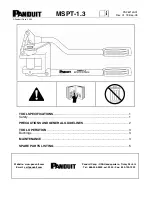
To perform a test, make sure the piston is extended and gently press the
Rebound Hammer against the concrete surface to be tested. When the piston
is pressed all the way into the Rebound Hammer, continue to push harder until
you hear a rattling sound. Keep the Rebound Hammer firmly pressed against
the concrete surface and read the rebound number on the scale.
As long as you hold the Rebound Hammer firmly against the concrete, the
rebound number will remain on the scale. Record your reading. When you pull
the hammer away and allow the piston to re-extend, the scale will return to zero.
The Rebound Hammer is now ready for another test. If desired, once you get a
reading, you may press the button on the handle to lock the piston in place.
This makes your test results easier to read, as it will also lock the indicator. Do
not touch the button until you get a reading. To release the piston again for the
next test, press against a hard surface. When you are finished using the Rebound
Hammer, lock the piston inside the Rebound Hammer for storage, as described
above.
Taking a Measurement
Selecting a Surface for Testing
Select a concrete surface that is:
• Smooth, dry, and fixed in place
• At least 4 inches (or 102 mm) thick
• Mature— at least 14 days old
• Free of any decay or scaling
If necessary grind a section of rough concrete smooth before taking your
readings. A grind stone in a plastic case is provided with the hammer for this
purpose.
Figure 3: Push the piston in as far as it will go


























